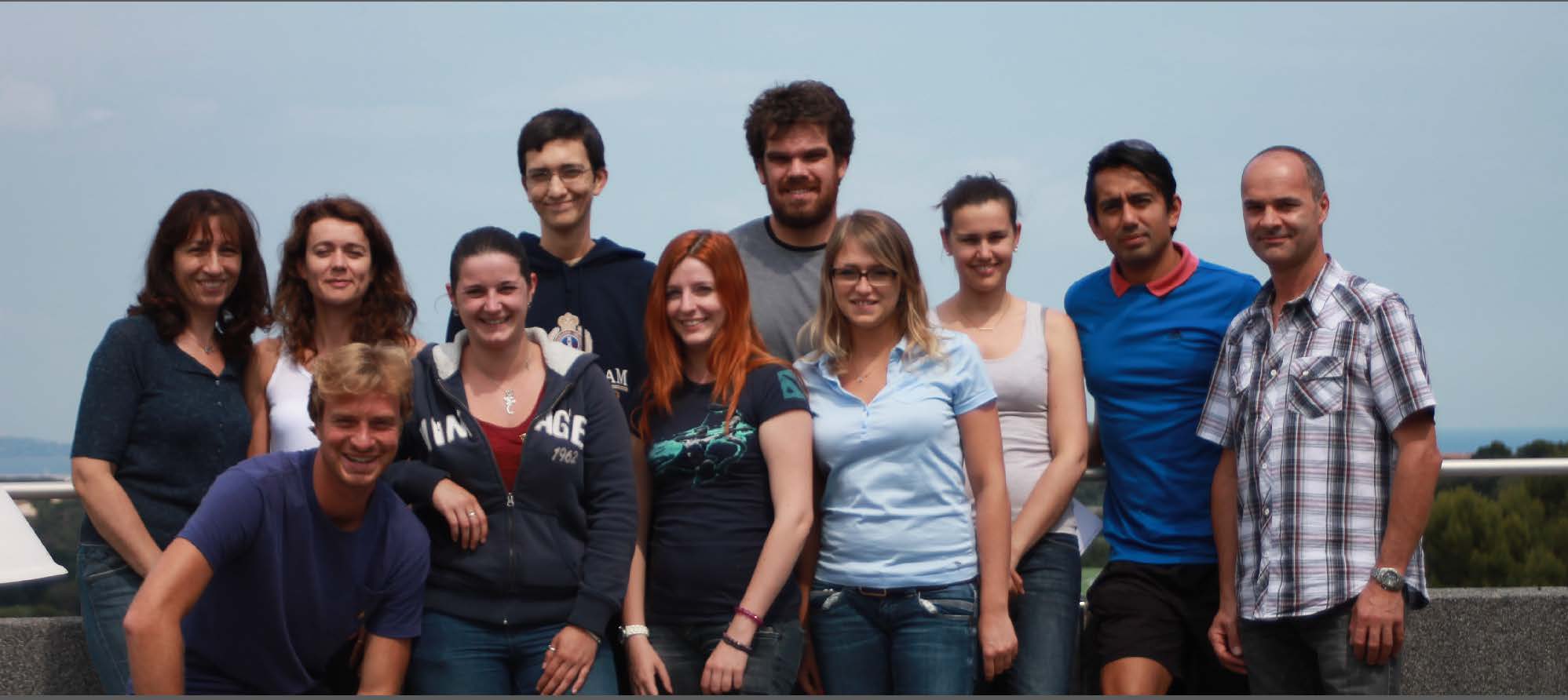Highlight on one 2014 Labex Publication
Tomas NM, Beck LH, Meyer-Schwesinger C, Seitz-Polski B, Ma H, Zahner G, Dolla G, Hoxha E, Helmchen U, Dabert-Gay AS, Debayle D, Merchant M, Klein J, Salant DJ, Stahl RA, Lambeau G Thrombospondin Type-1 Domain-Containing 7A in Idiopathic Membranous Nephropathy N. Engl. J. Med. 2014 Nov;
http://www.ncbi.nlm.nih.gov/pubmed/25394321
Impact Factor 54
Team Gérard Lambeau : “Molecular physiopathology of phospholipases A2 and their mediators”
Press releases in the French media :
http://www.cnrs.fr/insb/recherche/parutions/articles2014/g-lambeau.html
http://unice.fr/fil/service-communication/actualites/une-nouvelle-avancee-majeure-dans-le-diagnostic-de-la-glomerulonephrite-extra-membraneuse-idiopathique-1
Press releases in the USA media :
http://www.eurekalert.org/pub_releases/2014-11/ason-spa111714.php#
http://www.sciencedaily.com/releases/2014/11/141117111652.htm
http://www.medpagetoday.com/MeetingCoverage/ASN/48585
http://www.pubfacts.com/detail/25394321/Thrombospondin-Type-1-Domain-Containing-7A-in-Idiopathic-Membranous-Nephropathy
[ Print | E-mail ] ![]() Share
Share
Contact: Kurtis Pivert kpivert@asn-online.org 202-699-0238
American Society of Nephrology@ASNKidney
Second protein associated with common cause of kidney failure identified
Discovery could allow clinicians to diagnose and monitor renal autoimmune disorder
Philadelphia, PA (November 17, 2014) — An international team of researchers from France, Germany, and the US have identified a protein that turns a person’s immune system against itself in a form of kidney disease called membranous nephropathy (MN). The new research was presented at ASN Kidney Week 2014 in Philadelphia and published online in the New England Journal of Medicine.
Membranous nephropathy occurs when the small blood vessels in the kidney that filter wastes from the blood are damaged by circulating autoantibodies. As a result, proteins leak from the damaged blood vessels into the urine. For many people, loss of these proteins eventually causes signs and symptoms known as nephrotic syndrome.
Unchecked, MN can lead to kidney failure, or end-stage renal disease (ESRD). In 2011, more than a million people worldwide suffered from kidney failure annually, with more than 570,000 in the United States. Approximately 14% of ESRD is associated with glomerulonephritis, of which MN is a common form.
This is the second protein associated with MN and the development of an autoimmune response. Through the identification of this second protein, a new blood test can be developed to diagnose and monitor this common form of kidney disease.
The international research team included collaborators from Nice, France (Nicola M. Tomas, MD, Barbara Seitz-Polski, MD, Guillaume Dolla, MS, Anne-Sophie Dabert-Gay, PhD, Delphine Debayle, PhD, and Gérard Lambeau, PhD, of Centre National de la Recherche Scientifique and Université de Nice Sophia Antipolis, Valbonne); Hamburg, Germany (Catherine Meyer-Schwesinger, MD, Gunther Zahner, PhD, Elion Hoxha, MD, Udo Helmchen, MD, and Rolf A. K. Stahl, MD of University Medical Center Hamburg-Eppendorf); Boston, MA (Laurence H. Beck Jr, MD, PhD, Hong Ma, PhD, David J. Salant, MD, of the Boston University School of Medicine); and Louisville, KY (Jon B. Klein, MD, PhD, and Michael Merchant, PhD of the University of Louisville).
In 2009 this international team of scientists reported the discovery of phospholipase A2 receptor 1 (PLA2R1) as the protein targeted by autoantibodies in up to 70% of people suffering from MN. However, the target antigen in the remaining 30% of patients remained unknown. As pointed out by senior author Gérard Lambeau, PhD, Director of Research at CNRS and team leader at the Institute of Molecular and Cellular Pharmacology (Sophia Antipolis), « this week’s disclosure is related to the discovery of the protein THSD7A and the corresponding anti-THSD7A autoantibodies in a group of about 10% of MN patients who did not have anti-PLA2R1 autoantibodies. » This finding thus identifies a distinct group of MN patients with anti-THSD7A as a likely biomarker of disease activity.
« The discovery of this second antigen-antibody system in membranous nephropathy will allow clinicians to diagnose this new form of primary (autoimmune) membranous nephropathy and provides a new method to monitor the disease activity in this subgroup of patients, » said co-lead authors Nicola Tomas, MD of University Medical Center Hamburg-Eppendorf and Laurence Beck, MD, PhD, of Boston University School of Medicine.
« Five years ago this team initially discovered a protein that has led to a blood test identifying approximately 70% of people with MN, » said coauthor Jon Klein, MD, PhD, Vice Dean of Research at the University of Louisville. « The team has now found another protein that impact additional patients with MN. Once a blood test is available, we will have additional tools to follow the response to treatment and possibly reduce the number of kidney biopsies necessary for disease detection. »
« Our discovery of PLA2R1 as the target of autoantibodies energized research and accelerated the pace of discovery in this uncommon but serious cause of kidney disease, » said David Salant, MD, Chief of Nephrology and Professor of Medicine at Boston University School of Medicine. « Hopefully, our current findings will spur further research to identify the target antigen to benefit the remaining 20% of patients with MN ».
« This is significant because it provides us with another marker of identification and enables us to lessen the physical burden on our patients because they don’t have to undergo additional kidney biopsies to follow the course of MN, » Dr. Klein said.
« This discovery also represents an excellent example of international collaboration, with the decision to combine the independent discoveries of this target antigen by groups on both sides of the Atlantic into a jointly authored manuscript, », emphasized Dr. Beck and also Pr. Rolf Stahl of University Medical Center Hamburg-Eppendorf.
###
Study: « Identification of Thrombospondin Type 1 Domain Containing 7A as a Novel Antigen in Idiopathic Membranous Nephropathy » (Abstract TH-OR071)
Disclosure information is available at: http://www.asn-online.org/education/kidneyweek/2014/program-faculty.aspx.
ASN Kidney Week 2014, the largest nephrology meeting of its kind, will provide a forum for more than 13,000 professionals to discuss the latest findings in renal research and engage in educational sessions related to advances in the care of patients with kidney and related disorders. Kidney Week 2014 will take place November 11-16, 2014 in Philadelphia, PA.
The content of this article does not reflect the views or opinions of The American Society of Nephrology (ASN). Responsibility for the information and views expressed therein lies entirely with the author(s). ASN does not offer medical advice. All content in ASN publications is for informational purposes only, and is not intended to cover all possible uses, directions, precautions, drug interactions, or adverse effects. This content should not be used during a medical emergency or for the diagnosis or treatment of any medical condition. Please consult your doctor or other qualified health care provider if you have any questions about a medical condition, or before taking any drug, changing your diet or commencing or discontinuing any course of treatment. Do not ignore or delay obtaining professional medical advice because of information accessed through ASN. Call 911 or your doctor for all medical emergencies.
Founded in 1966, and with nearly 15,000 members, the American Society of Nephrology (ASN) leads the fight against kidney disease by educating health professionals, sharing new knowledge, advancing research, and advocating the highest quality care for patients.
http://www.eurekalert.org/pub_releases/2014-11/ason-spa111714.php#





